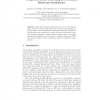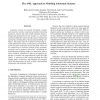514 search results - page 14 / 103 » Modelling Norms for Autonomous Agents |
ACMICEC
2007
ACM
13 years 11 months ago
2007
ACM
We present a semi-parametric model that describes pricing behaviors in a market environment, and we show how that model can be used to guide resource allocation and pricing decisi...
ATAL
2007
Springer
14 years 1 months ago
2007
Springer
Electronic institutions (EIs) define the rules of the game in agent societies by fixing what agents are permitted and forbidden to do and under what circumstances. Autonomic Elec...
AP2PC
2004
Springer
14 years 24 days ago
2004
Springer
Abstract. Peer-to-peer (P2P) architectures exhibit attractive properties for a wide range of real world systems. As a result they are increasingly being applied in the design of ap...
ATAL
2008
Springer
13 years 9 months ago
2008
Springer
Distributed systems comprised of autonomous self-interested entities require some sort of control mechanism to ensure the predictability of the interactions that drive them. This ...
ICAS
2006
IEEE
14 years 1 months ago
2006
IEEE
Autonomic systems are typically distributed, complex and concurrent systems, comprised of multiple interacting autonomic elements that often exhibit emergent behavior. Design and ...


